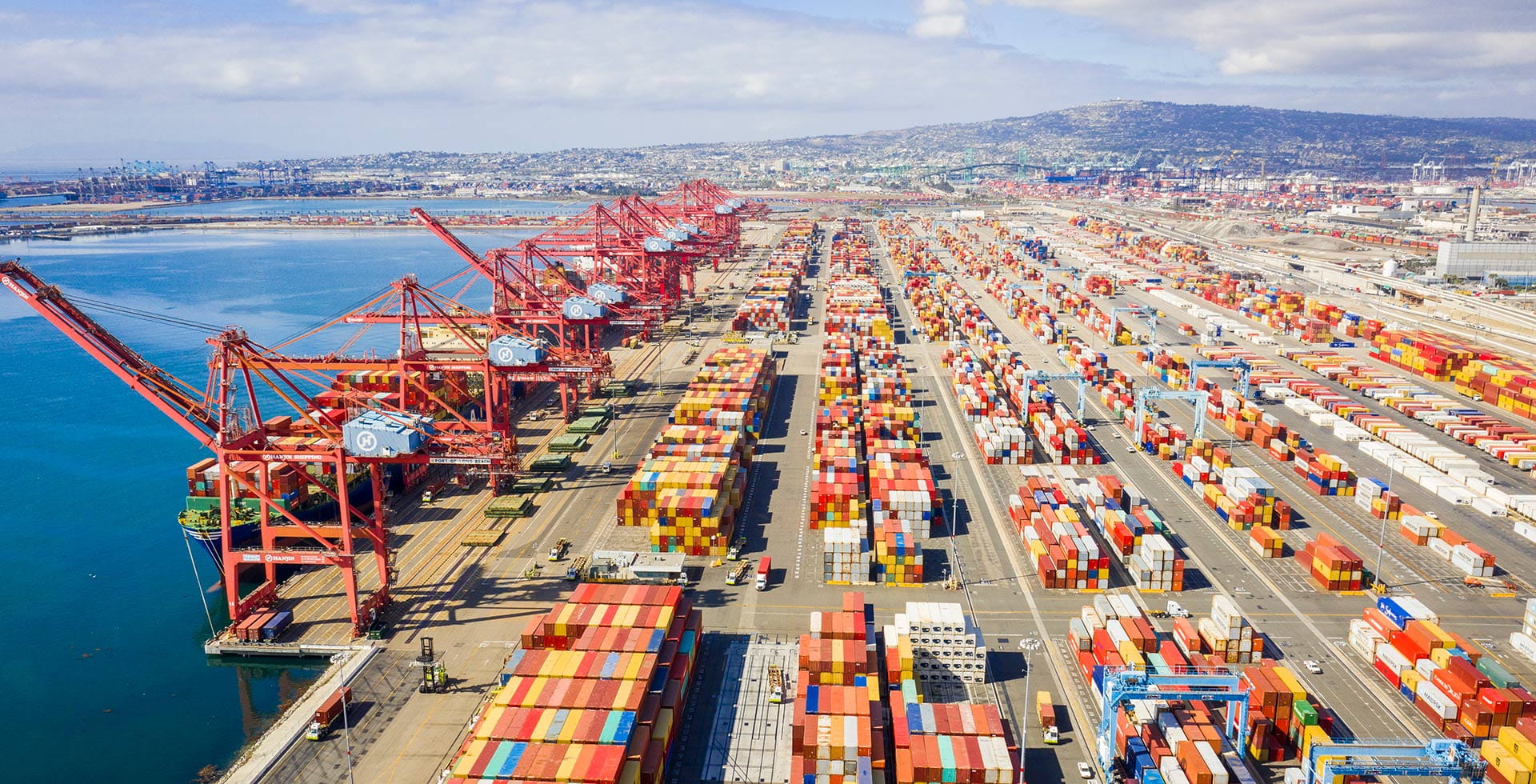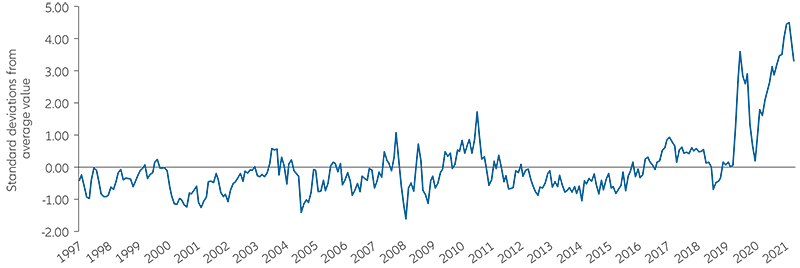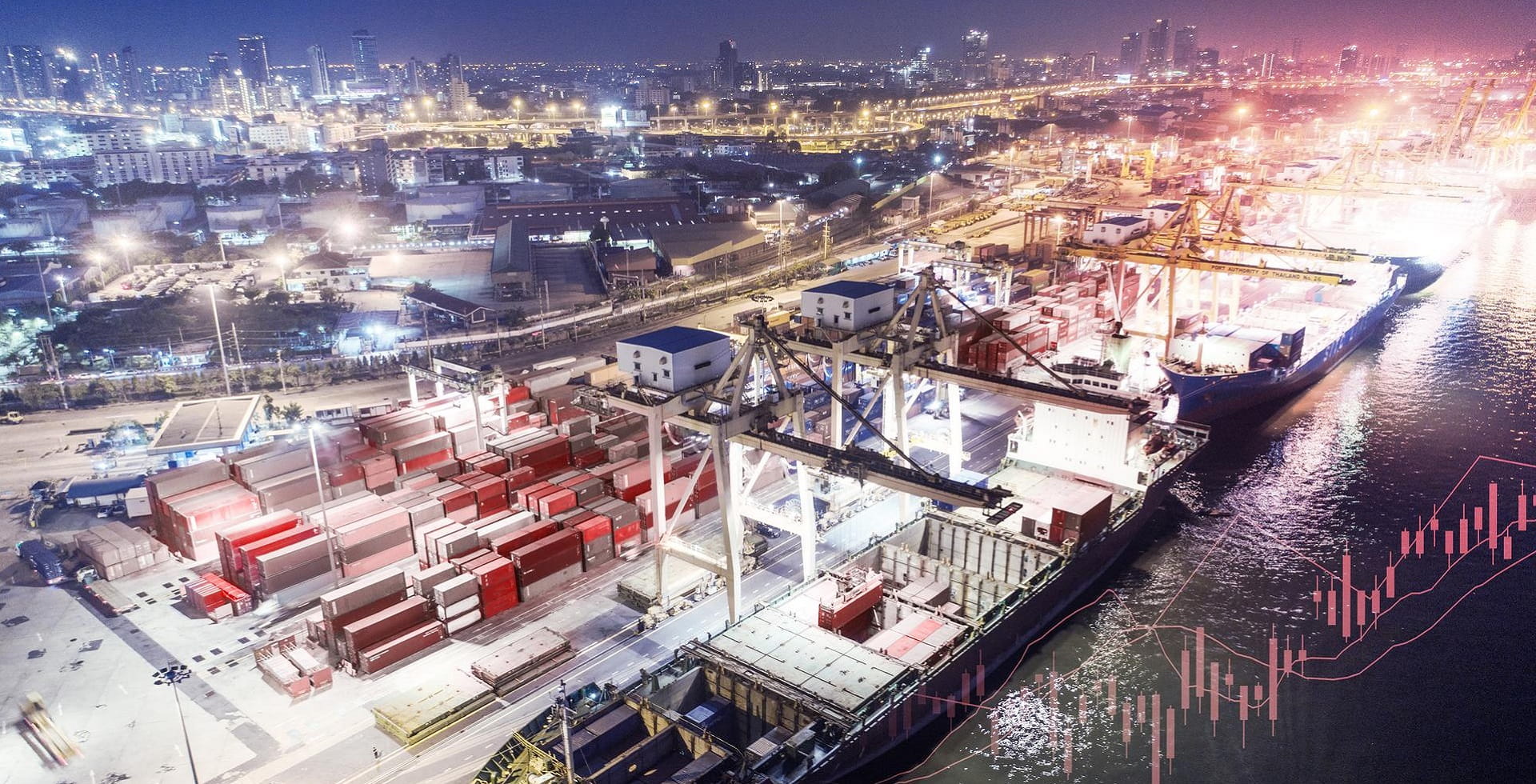Unpacking opportunities from supply chain innovation

Summary
Supply chains have been buffeted by an unprecedented slew of recent global events, dislocating the flow of goods and fanning inflationary pressures. But the challenges have also accelerated innovation – from businesses investing in artificial intelligence to streamline trade to diversifying suppliers to ensure continued flows of goods. The disruption is creating significant opportunities for investment to help future-proof supply chains against further upheavals.
Key takeaways
|
From rising petrol prices to delays in securing semiconductor chips, consumers and businesses have felt the impact of disrupted supply chains. The causes – from the multi-year continuing deglobalisation in some sectors to Covid-19 and, most recently, the Russia-Ukraine situation – are pushing up inflation and creating challenges for markets already grappling with shifting inflation expectations (see Exhibit 1). But it is also triggering profound changes in the world of commerce and how goods and services are traded, while creating exciting openings for investors.
Why have supply chains been hit?
Covid-19 caused significant disruption to supply chains as sudden changes in consumer spending – an initial drop and then a surge in demand, in part fuelled by government financial support – left retailers, wholesalers and manufacturers reeling at a time when ports, factories and other businesses were hampered by lockdowns of economies. With long lead times a supply chain feature, suppliers of sought-after goods struggled to keep pace with demand, pushing delivery times out and prices up1.
Other one-off events have further hampered trade – and 2021 had an abundance of them – spanning severe floods in Europe, a winter storm in Texas and a six-day blockage of the Suez Canal, a major shipping artery.
In a sign of the bottlenecks straining supply chains, transpacific shipments took an average of 80 days in December 2021, 37 days longer than in December 2019.2
Even before the pandemic, supply chains were feeling the strain from signs of creeping protectionism and a more self-sufficient approach – consider the US-China trade dispute and Britain’s exit from the European Union.
Exhibit 1: Global Supply Chain Pressure Index

Note: Based on global transportation costs measured using data on sea shipping costs, using data from the Baltic Dry Index (BDI) and the Harpex index, as well as BLS airfreight cost indices for freight flights bet
Source: Federal Reserve Bank of New York.
Russia-Ukraine uncertainty
The invasion of Ukraine has emerged as the latest obstacle to global trade. Since Russia is the world’s second largest oil exporter and largest gas exporter, the course of the crisis has consequences for two of the major commodities driving the global economy. Oil prices surged, hitting USD 130 per barrel, their highest level in 14 years, in March 2022. That has a direct knock-on effect on trade – consider the reported 80% rise in China to Europe air freight costs in late February.4
The conflict has sent shockwaves through other supply chains too as Russia is a big producer of materials such as palladium and nickel, while both Russia and Ukraine produce everything from wheat to barley, corn, and fertiliser.
How is the disruption triggering changes in global supply chains?
In response to the supply chain stresses, some companies are seeking to build more resilience into their operations against the risk of further upheavals. In many cases, the push to give their supply chains more flexibility and strength is an acceleration of changes they were already making before the shake-up of the last two years:
- Building inventory:
The pandemic left an indelible mark on global supply chains as some companies found themselves without inventory due to lockdowns or staff sickness. For example, at least one major car manufacturer temporarily suspended manufacturing operations in early 2020 after the pandemic disrupted the flow of parts.5
Events have encouraged some firms to consider overhauling just-in-time models that have formed the backbone of supply chain management for decades in favour of just-in-case, which requires holding greater inventory. Several car manufacturers are reported to be stockpiling chips, batteries, and other key components to ensure future deliveries. Some leading retailers have increased their use of “pack and hold inventory,” involving buying larger quantities of certain items and holding it in preparation for periods of high demand and tight supply. And other companies are making similar moves. A late 2020 survey of supply chain professionals by Gartner found 43% are investing now in increasing inventory, with a further 11% planning to do so within the next two years.6 - Nearshoring and reshoring:
Surging transport costs and delays in accessing materials have encouraged more firms to consider nearshoring, the process of transferring manufacturing or supplier business to a nearby country closer to the location of demand for its manufactured products. Some European fashion brands plan to move more manufacturing from Asia closer to European markets in response to rising shipping costs.7
In Asia, an important manufacturing and supply base, companies are diversifying their supply chains within the continent to build contingency in case of disruption. This trend has been hastened in recent years by the US-China trade dispute, a row that pushed up tariffs. A “China+1” supply chain strategy has seen other Asian countries including Vietnam, Indonesia, Malaysia, Thailand, and India benefit. Covid-19 has given China+1 renewed focus. Recent research from Australian logistics firm Toll Group found that of the more than one quarter of businesses it surveyed that have either already or are planning to move some of their work outside China within the next three years, 32% are considering Vietnam and 30% India.8
In some cases, governments are seeking to reduce their countries’ reliance on key components sourced from overseas. The United States, European Union and others have all announced plans to develop their own chipmaking industries. Eventually, that may help ease a global chip shortage stoked by surging demand for cars and other products that include chips, as well as pandemic-linked production problems.
One possible longer-term consequence of the recent heightened geopolitical tensions could be a polarisation of the two preeminent global ecosystems centred around the US and China. That could hasten supply chain reorganisations and even lead to reshoring, where businesses move manufacturing back home. - Investing in technology:
One of the challenges highlighted by the recent instability was that very few firms had an overview of their supply chains at every stage. Remote working too brought its own challenges. According to a 2021 McKinsey & Company survey, only 2% of supply chain leaders had visibility into their supply base beyond the second tier, the term for those companies contracted via a vendor.9 Here advanced analytics can help companies plan and navigate risks. The use of data to simulate events or provide deeper insights is being harnessed by increasing numbers of firms. According to the same McKinsey survey, companies that reported successfully managing the pandemic were 2.5 times more likely to report they had pre-existing advanced-analytics capabilities.
Robotics is the other new technology transforming supply chains. In recent years, firms began turning to robots as a way to offset higher labour costs. But their role became more integral still during the pandemic as companies grappled with labour shortages. Cheaper and more competent than ever, robots can streamline the speed and efficiency of routine tasks such as inventory checks and fulfilment practices, while allowing human workers to focus on more value-added tasks.
What does the disruption mean for investors?
While the disruption may squeeze company profit margins, particularly in those sectors most vulnerable to supply shortages such as industrials, it is also driving wide-scale innovation. This creates opportunities for investors.
Here are four investment ideas in a world of dislocated supply chains:
- Data centres: as global commerce has been roiled by dislocations, more businesses have sought to better manage the complexity of their supply chains. That has helped spur demand for data centres and the technology that power them to handle the increasing shift to digital transactions and operations. The online shopping and working from home revolution, accelerated by the pandemic, added to positive tailwinds data centres were already experiencing from the needs of cloud storage, more devices being connected to the internet, e-commerce and streaming services. Combined these factors helped to push up investment in the sector by 60% in 2021, according to JLL. Investors can also seek out opportunities from the manufacturers of the equipment within the data centres and the providers of the services linked to them. In the case of the UK, the world’s second-largest data centre market, Brexit is providing an additional accelerator as a move to UK specific data legislation leads more companies to open or grow data centre facilities. Government regulations are helping stoke demand in other countries too. China, Turkey, Australia, France and Germany have data localisation requirements, which – to different degrees – require that certain data of individuals in those countries be held locally.10
Investor takeaway: Data centres offer diversification and exposure to assets with long-term growth drivers. - Agricultural technology: the Russian government’s recent ban on exports of over 200 products included key soft commodities such as wheat, sugar and agricultural equipment. Russia and Ukraine’s position as top producers of sunflower oil is creating more disruption across food markets. Food security fears have been further fanned by a decline in crop planting by farmers in Ukraine, a key exporter of soft commodities like wheat and barley. Against a backdrop of food prices already reaching record highs in February 2022, we think this could lead to higher farm income in the US and Latin America as alternative markets are sought out, opening the way for more investment in agricultural technology and water irrigation equipment. The sector’s long-term growth outlook has strengthened in recent years as more countries seek to build resilience into food supply chains to reduce the impact of increasingly regular natural events such as drought and floods brought on by climate change. The Covid-19 pandemic added an additional tailwind as agricultural commodity prices surged due to supply shortages. Investment in farm tech venture capital, spanning everything from the use of robots to GPS technology, surged to USD 7.9 billion in 2020, up 41% from the previous year.11 That spending is likely to ramp up further as modern farm technology brings down usage of water, fertiliser and pesticides.
Investor takeaway: the Ukraine-Russia situation is likely to sharpen a focus on food security, adding a further tailwind to a sector viewed as an integral long-term part of building resilience into global food supply chains in the face of climate change.
Investment in farm tech venture capital
Increased to USD 7.9 billion in 2020 from USD 5.6 billion in 2019 up 41% from 201912
- Renewable energy: soaring hydrocarbon prices in the wake of the Russia-Ukraine crisis provide a stark reminder of the global economy’s vulnerability to volatile energy markets. Sanctions, including the United States and UK’s ban on Russian oil and gas imports and Germany’s intention to end Russian oil imports by the end of 2022, add further uncertainty to future global fossil fuel supplies. The disruption is set to accelerate investment in renewable energy, particularly in Europe, which relies on Russia for 45% of its natural gas imports and around a third of its oil imports, as countries seek greater energy independence.13 As its produced locally, renewable energy represents one of the most effective strategies for reducing reliance on international energy providers. Europe has long been committed to the energy transition. The European Commission adopted a set of proposals to make the EU’s climate, energy, transport and taxation policies fit for reducing net greenhouse gas emissions by at least 55% by 2030 compared to 1990 levels. We believe the crisis will add meaningful fiscal and political support to alternative forms of energy as decision makers aim to move long-term timelines forward, improve regulatory support and increase spending.
Investor takeaway: political and financial focus on renewable energy is set to intensify in the wake of the Ukraine situation, a push likely to require significant funding from private investors. - Robotics: from managing greater inventory build-up to helping pack shipments more efficiently, robots are increasingly being seen as a solution by many companies to the greater complexity rippling through supply chains. In a world of deglobalisation in some sectors where companies face higher costs from rising wages and overall higher inflation, as well as supply shocks, investment in automation and robotics will be increasingly seen as a way to mitigate risks to fragile supply chains. So, what is the potential for greater investment in robotics long-term? Currently, there are 126 industrial robots per 10,000 manufacturing jobs globally, implying a robot density of about 1%. High single-digit robot density in manufacturing hubs like South Korea and Singapore shows the potential for future growth in markets such as China, the US and France, where density is much lower (see Exhibit 2).14
Investor takeaway: businesses across supply chains will turn to robots as they rethink how they move goods to customers and to future-proof their operations against supply and cost risks.
Exhibit 2: Robot density in the manufacturing industry

Note: Robot density nearly doubled globally - International Federation of Robotics (ifr.org)
Source: World Robotics 2021
What is the outlook for supply chains?
Before the Ukraine invasion we had been predicting a supply chain recovery in the second half of 2022 as production growth recovered. But the crisis is a fresh headwind to the global economy, adding downside risks to a gradual recovery from the Covid-19 pandemic.
Much depends on how the invasion pans out, but also the course of sanctions imposed by the West against Russia.
In addition to surging commodity prices, the crisis has prompted disruption right across the corporate world – from freight suppliers cancelling shipments to the country to oil majors seeking to sell business units and some companies pulling out of Russia altogether. In a move that will further complicate commerce, some Russian banks are also being frozen out of the global financial system.
And Covid-19 challenges persist. The latest lockdowns in major parts of China are raising fresh obstacles to global trade.
The continuing long-term deglobalisation in some sectors will also present challenges. For example, China’s dual circulation policy, a push to boost consumer spending at home while continuing to promote manufacturing prowess internationally, will help shape the role of the world’s second-largest trader of goods in the global economy and the development of supply chains for years to come.
1 Challenges have been magnified by a phenomenon known as the “bullwhip effect” as swings in consumer demand were amplified up the supply chain from the retailer through to the wholesaler and manufacturer due to a variance of orders. This can create a supply-demand mismatch.
2 Source: Freight Waves: Imports take "dramatically longer" to reach US as bottlenecks bite, January 2022
3 Source: Freight Waves: Imports take "dramatically longer" to reach US as bottlenecks bite, January 2022
4 Source: CNBC: How the Russia-Ukraine war is worsening shipping snarls and pushing up freight rates, March 2022
5 Source: Reuters: Hyundai to halt South Korea output as China virus disrupts parts supply, February 2022
6 Source: Gartner Research: Supply Chain Executive Report: Future of Supply Chain — Crisis Shapes the Profession
7 Source: Reuters: How global supply chains are falling out of fashion, September 2021
8 Source: Toll Group: https://www.tollgroup.com/future-logistics/how-covid-19-has-accelerated-china-plus-one
9 Source: McKinsey & Company: How COVID-19 is reshaping supply chains, November 2021
10 Source: United States International Trade Commission: Data Centers Around the World: A Quick Look, May 2021
11 Source: AgFunder: 2021 Farm Tech Investment Report
12 Source: AgFunder: 2021 Farm Tech Investment Report
13 Source: International Energy Agency: Frequently Asked Questions on Energy Security, March 2022
14 Source: International Federation of Robotics: Robot density nearly doubled globally , December 2021
Diversification does not guarantee a profit or protect against losses.
Investing involves risk. The value of an investment and the income from it will fluctuate and investors may not get back the principal invested. Past performance is not indicative of future performance. This is a marketing communication. It is for informational purposes only. This document does not constitute investment advice or a recommendation to buy, sell or hold any security and shall not be deemed an offer to sell or a solicitation of an offer to buy any security.
The views and opinions expressed herein, which are subject to change without notice, are those of the issuer or its affiliated companies at the time of publication. Certain data used are derived from various sources believed to be reliable, but the accuracy or completeness of the data is not guaranteed, and no liability is assumed for any direct or consequential losses arising from their use. The duplication, publication, extraction, or transmission of the contents, irrespective of the form, is not permitted.
This material has not been reviewed by any regulatory authorities. In mainland China, it is for Qualified Domestic Institutional Investors scheme pursuant to applicable rules and regulations and is for information purpose only. This document does not constitute a public offer by virtue of Act Number 26.831 of the Argentine Republic and General Resolution No. 622/2013 of the NSC. This communication's sole purpose is to inform and does not under any circumstance constitute promotion or publicity of Allianz Global Investors products and/or services in Colombia or to Colombian residents pursuant to part 4 of Decree 2555 of 2010. This communication does not in any way aim to directly or indirectly initiate the purchase of a product or the provision of a service offered by Allianz Global Investors. Via reception of his document, each resident in Colombia acknowledges and accepts to have contacted Allianz Global Investors via their own initiative and that the communication under no circumstances does not arise from any promotional or marketing activities carried out by Allianz Global Investors. Colombian residents accept that accessing any type of social network page of Allianz Global Investors is done under their own responsibility and initiative and are aware that they may access specific information on the products and services of Allianz Global Investors. This communication is strictly private and confidential and may not be reproduced. This communication does not constitute a public offer of securities in Colombia pursuant to the public offer regulation set forth in Decree 2555 of 2010. This communication and the information provided herein should not be considered a solicitation or an offer by Allianz Global Investors or its affiliates to provide any financial products in Brazil, Panama, Peru, and Uruguay. In Australia, this material is presented by Allianz Global Investors Asia Pacific Limited (“AllianzGI AP”) and is intended for the use of investment consultants and other institutional/professional investors only and is not directed to the public or individual retail investors. AllianzGI AP is not licensed to provide financial services to retail clients in Australia. AllianzGI AP is exempt from the requirement to hold an Australian Foreign Financial Service License under the Corporations Act 2001 (Cth) pursuant to ASIC Class Order (CO 03/1103) with respect to the provision of financial services to wholesale clients only. AllianzGI AP is licensed and regulated by Hong Kong Securities and Futures Commission under Hong Kong laws, which differ from Australian laws.
This document is being distributed by the following Allianz Global Investors companies: Allianz Global Investors U.S. LLC, an investment adviser registered with the U.S. Securities and Exchange Commission; Allianz Global Investors Distributors LLC, distributor registered with FINRA, is affiliated with Allianz Global Investors U.S. LLC; Allianz Global Investors GmbH, an investment company in Germany, authorized by the German Bundesanstalt für Finanzdienstleistungsaufsicht (BaFin); Allianz Global Investors (Schweiz) AG; in HK, by Allianz Global Investors Asia Pacific Ltd., licensed by the Hong Kong Securities and Futures Commission; ; in Singapore, by Allianz Global Investors Singapore Ltd., regulated by the Monetary Authority of Singapore [Company Registration No. 199907169Z]; in Japan, by Allianz Global Investors Japan Co., Ltd., registered in Japan as a Financial Instruments Business Operator [Registered No. The Director of Kanto Local Finance Bureau (Financial Instruments Business Operator), No. 424], Member of Japan Investment Advisers Association, the Investment Trust Association, Japan and Type II Financial Instruments Firms Association; in Taiwan, by Allianz Global Investors Taiwan Ltd., licensed by Financial Supervisory Commission in Taiwan; and in Indonesia, by PT. Allianz Global Investors Asset Management Indonesia licensed by Indonesia Financial Services Authority (OJK).
2124541
Supply chain snapshot: uncovering opportunities despite disruption

Summary
Quick answers to some of the most common supply chain questions.






